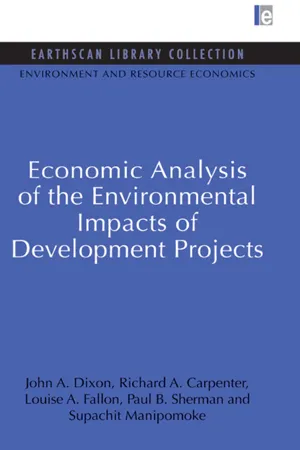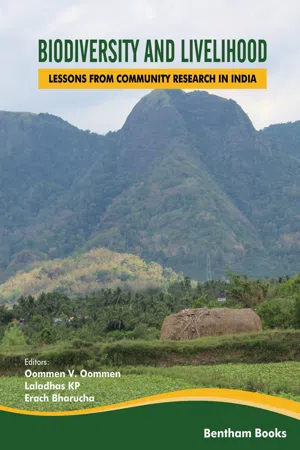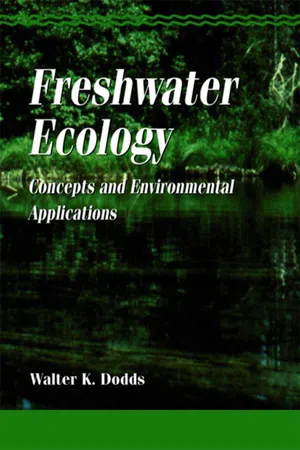Environmental Impact of Fishing
The environmental impact of fishing refers to the effects of fishing activities on the marine ecosystem. These impacts can include overfishing, bycatch of non-target species, habitat destruction, and pollution from fishing vessels. Overfishing can lead to declines in fish populations and disrupt the balance of marine ecosystems, while bycatch and habitat destruction can harm non-target species and their habitats.
6 Key excerpts on "Environmental Impact of Fishing"
- eBook - ePub
- Simon Jennings, Michel Kaiser, John D. Reynolds(Authors)
- 2013(Publication Date)
- Wiley-Blackwell(Publisher)
...14 Impacts on benthic communities, habitats and coral reefs 14.1 Introduction Fishers use a great array of techniques and equipment to capture their prey. No matter which fishing technique is used, fishers and/or their gear interact with the habitat to some degree, for example, trampling intertidal fauna while collecting snails, lost fishing lines entangling non-target species, pots and traps landing on top of benthic fauna, and nets dragging across the seabed. The interaction of fishing gear with the environment either disturbs the habitat directly (physical disturbance) or indirectly, by removing competitors and predators from the system (biological disturbance). The environmental effects of fishing gears that are deployed at the surface of the sea or in mid-water are caused by gear loss and the direct and indirect consequences of removing bycatch and prey species. In contrast, most methods of fishing for bottom-dwelling species affect the seabed habitat and its inhabitants to some degree. The aim of this chapter is to describe the ecological consequences of fishing on the seabed, both intertidally and subtidally. We consider the role of fishing activities as an agent of physical disturbance acting against a background of natural disturbance, the direct impacts of fishing methods and their effects on habitat structure, benthic communities and non-target species. We investigate long-term changes that might be linked to the effects of physical disturbance or the redirection of energy within the ecosystem and discuss the indirect effects of fisheries on habitat structure and production processes. Finally, we consider the direct and indirect effects of fishing on coral reefs and associated ecosystems. 14.2 Fishing disturbance 14.2.1 Fishing vs. natural disturbance It is important at the outset to acknowledge that fishing is a form of physical disturbance as defined by Pickett and White (1985) (Box 14.1)...
- eBook - ePub
Fisheries and Aquaculture
The Food Security of the Future
- Ágúst Einarsson, Ásta Dís Óladóttir(Authors)
- 2020(Publication Date)
- Academic Press(Publisher)
...Many of these island states are also dependent on fisheries and aquaculture. The acidification of the oceans and depletion of oxygen in the sea have a negative impact on marine life, and signs of deterioration are already seen in various areas, such as the coral reefs of the south seas, algae, and shellfish. Among other effects of pollution of the seas is the presence of hazardous substances, such as heavy metals and chemical contaminants in marine organisms. The impact of global warming on the marine ecosystem is significant, affecting, among other things, the spawning grounds of fish, causing changes or even disappearances of fishing grounds and potentially reducing the availability of food. Warming of the sea also reduces plant activity in the sea and inhibits photosynthesis. Thus fisheries and aquaculture are highly dependent on efforts to combat global warming. Because of the growing public awareness of environmental issues, and because of increasing surveillance by national and international supervisory measures, the traceability of products has become an increasingly common requirement in marketing fish products, whether caught or farmed. It has therefore become important for businesses to be able to demonstrate that fish and its products were obtained by means of sustainable fishing, farming, and processing. If this cannot be demonstrated, there is a risk of the fish fetching a lower price, or even being impossible to sell through established retail channels. Taking into account the fact that about 33% of all fish stocks are currently overexploited, as compared to only 10% some 40 years ago, the trend would appear to be away from sustainable fishing. For this reason, it is more urgent than ever before to set the environment and sustainability as principal aims in world fisheries, not least in the interests of food security for the world population...
- John A. Dixon, Richard A. Carpenter, Louise A. Fallon, Paul B. Sherman, Supachit Manipomoke(Authors)
- 2013(Publication Date)
- Routledge(Publisher)
...Their role goes beyond merely providing a location for fishing. Many species of fish and crustaceans are dependent on near-shore waters during at least part of their life cycle. Mangrove swamps and inshore waters, for example, provide nursery areas and breeding grounds for many species which are commercially exploited in deeper waters later in their lives. Fish, as well as being an important export product, are a vital source of animal protein in most developing countries. The artisanal fisheries and the small-scale fish-processing factories are also important sources of income in many coastal areas. Any reduction in the productivity of fisheries therefore, has considerable socioeconomic consequences. Integrated analyses of coastal zones can reveal the impact of development projects upon the affected natural systems and allow the evaluation of the associated socioeconomic losses. Table 1: Linkage between Development Activities and their Physical, Ecological and Socioeconomic Consequences Source: R.A. Carpenter (ed.), Natural Systems for Development: What Planners Need to Know (New York: Macmillan, 1983). AIR POLLUTION FROM INDUSTRIAL FACILITIES Air which is polluted by industry can seriously affect people as well as crops, livestock and materials. Pollution damage may occur at some distance from the source because its distribution depends on the vagaries of wind and terrain. Since emission controls are usually more costly to install after the initial design and construction of an industrial facility, it is important that they be included during the early stages of project planning and design. One valuable tool for estimating the effects of emissions from plants such as coal-fired power stations or fertilizer manufacturing plants is the definition of an air quality control region (AQCR)...
- Oommen V. Oommen, Laladhas K. P., Erach Bharucha(Authors)
- 2020(Publication Date)
- Bentham Science Publishers(Publisher)
...However, the impacts often remain neglected, especially in designing adaptation measures. Changes in water temperature, precipitation and oceanographic variables, such as wind velocity, wave action and sea level rise, can bring about significant ecological and biological changes to marine ecosystems and their resident fish populations, directly impacting peoples whose livelihoods depend on those ecosystems. Extreme weather events may also disrupt fishing operations and land-based infrastructure, while fluctuations of fishery production and other natural resources can have an impact on livelihoods strategies and outcomes of fishing communities [ 39, 40 ]. According to the fishermen’s perspective [ 41 ], the impacts of climate change on the livelihood are from multiple sectors (Fig. 3). In coastal zones, potential declines in mangrove forest habitat resulting from sea level rise, changes in sediment and pollutant loading from river and lake basins combined with land reclamation for agriculture or overexploitation could also impact on fisheries by reducing or degrading critical coastal habitats. Mangrove forest loss for instance can negatively affect the diversity of benthic invertebrates such as tiger prawns or mud crabs [ 38 ]. Fig. (3)) Impacts of climate change on livelihoods: Fisherfolk’s perspective. Strategies to Combat Climate Change Climate change involves complex interactions between climatic, environmental, economic, political, institutional, social, and technological processes. It cannot be addressed or comprehended in isolation of broader societal goals (such as equity or sustainable development), or other existing or probable future sources of stress...
- eBook - ePub
Freshwater Ecology
Concepts and Environmental Applications
- Walter K. Dodds(Author)
- 2002(Publication Date)
- Academic Press(Publisher)
...21 Fish Ecology and Fisheries Biogeographical Determinants of Fish Assemblage Diversity Physiological Aspects Influencing Growth, Survival, and Reproduction Population Dynamics of Fishes Regulating Exploitation of Fish Stocks Stocking Fish for Fisheries Aquaculture Summary Questions for Thought FIGURE 21.1 A large pike (Essox lucius) (photograph courtesy of Chris Guy). Much of the economic impetus behind protecting freshwaters is related to maintenance of productive sport and commercial fisheries. Fish dominate many freshwater food webs as the top predators in streams and lakes. Fish are good indicators of water quality and model organisms for physiological and behavioral research. Knowledge of fish ecology can assist in determining species that are prone to extinction (Angermeier, 1995) and what steps should be taken for conservation. In this chapter, I discuss the biogeography of fish communities and factors that influence growth, survival, and reproduction of fishes. Populations and production of fish are briefly described, as are harvesting, management, and aquaculture methods. BIOGEOGRAPHICAL DETERMINANTS OF FISH ASSEMBLAGE DIVERSITY Diversity of organisms was discussed Chapter 10, but this chapter will provide more detail on fish. Fisheries biologists in developed countries have become more involved with management of nongame species, including enhancement of biodiversity and protection of endangered species. These aspects of fisheries biology require consideration of factors that influence diversity and distribution of fish. Patterns will be described from the most general to the smallest scale. The numbers of species are approximately the same for freshwater and marine fish. On a continental scale, fish communities are more diverse on large continents than on smaller continents or islands. Also, consistent with many other animal and plant groups, fish species are richer in the tropics than in temperate zones...
- eBook - ePub
- Katherine L. Yates, Corey J. A. Bradshaw, Katherine L. Yates, Corey J. A. Bradshaw(Authors)
- 2018(Publication Date)
- Routledge(Publisher)
...Chapter 8 Environmental implications of offshore energy Andrew B. Gill, Silvana N.R. Birchenough, Alice R. Jones, Adrian Judd, Simon Jude, Ana Payo-Payo and Ben Wilson Introduction Activities associated with offshore energy extraction and generation have implications for the surrounding marine environment (Gill 2005; Inger et al. 2009; Boehlert and Gill 2010; Miller et al. 2013), and while our understanding of those implications has improved, particularly for marine megafauna (i.e., large mammals such as whales, dolphins and seals, and large fish such as sharks and some bony fishes), much remains unknown about how offshore energy activities affect marine ecosystems (Inger et al. 2009; Boehlert and Gill 2010). This uncertainty can limit the capacity to environmental changes associated with offshore energy development bring marine spatial planning processes, subsequently reducing confidence in within planning decisions which promote an energy mix to combat climate change. Most evidence of how offshore energy activities affect the marine environment comes from studies of direct changes or responses (termed ‘effects’) that can be quantified for only a few species or habitats (known as environmental ‘receptors’) (Boehlert and Gill 2010). There is also a preponderance of negative effects reported, such as the potential threats of temporary displacement or mortality to megafauna (Simmonds and Brown 2010). Often, the motivation to examine these hypothesised effects is a requirement under an environmental impact assessment (Judd et al. 2015; Willsteed et al. 2017). One important and generally unanswered question is whether the effects observed are ecologically meaningful, such as population-level change resulting from reduced fitness of individual animals (King et al...





